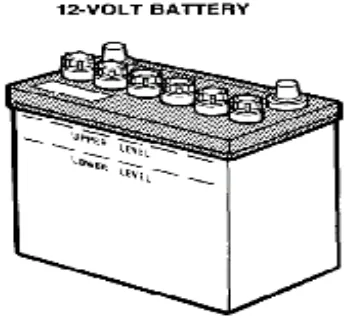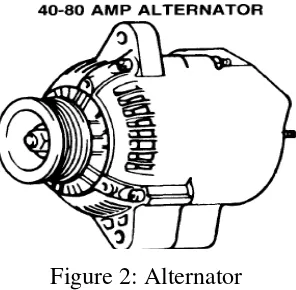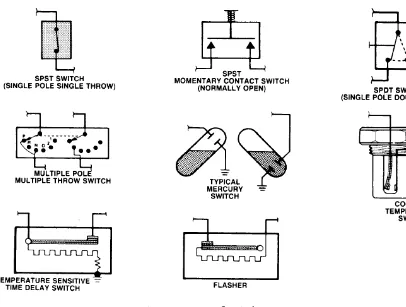DESIGN OF AUTOMOTIVE CHASSIS ELECTRICAL SYSTEM TRAINING BOARD
AHMAD FIRDAUS BIN MOHAMMAD MOHSIN
DESIGN OF AUTOMOTIVE CHASSIS ELECTRICAL SYSTEM TRAINING BOARD
AHMAD FIRDAUS BIN MOHAMMAD MOHSIN
This report is presented in
Partial fulfillment of the requirements for the Bachelor of Mechanical Engineering (Automotive)
Faculty of Mechanical Engineering Universiti Teknikal Malaysia Melaka
ii
I hereby declared that this report is a result of my own work except for the excerpts that have been cited clearly their references.”
Signature : ………
iii
For my beloved father and mother
iv
ACKNOWLEDGEMENTS
Alhamdulillah, praise be to Allah S.W.T, the Cherisher and Sustainer of world, most Gracious, most Merciful Lord. Praise be to Allah S.W.T for enabling me to completed this final year bachelor degree project.
I would like to thank advisor, En Herdey Rusnandy as my supervisor, for his invaluable help, support and ideas to me through achieving my goals on “Projek Sarjana Muda 2”. Her countless contributions in this project will remind forever in my mind. During the completion, I had collaborated with many colleagues for whom I
have great regards and I want to extend my warmest thanks to all those who helped me with my work especially house mate.
v
ABSTRACT
vi
ABSTRAK
vii
TABLE OF CONTENT
CHAPTER TITLE PAGE
PREFACE ii
DEDICATION iv
ACKNOWLEDGEMENT v
ABSTRAK vi
ABSTRACT vii
TABLE OF CONTENT viii
LIST OF TABLE x
LIST OF FIGURE xi
LIST OF SYMBOL xii
1 INTRODUCTION
1.1 Background 1
1.2 Objective 1
1.3 Scope 2
1.4 Problem statement 2
2 LITERATURE REVIEW
2.1 Introduction 3
2.2 Power Sources on Car 3
2.3 Controls 5
2.4 Circuit Protection Devices 10
2.5 An overview of Automobile Lighting System 11
2.6 Conductors and Insulators 14
2.7 Direct Current (DC) 15
viii
2.9 Factors that affect resistance 18
2.1 Theory Calculation 18
2.11 Complete electrical circuit 21
Research from available product 23
Sample Wiring Diagram 25
3 METHODOLOGY
3.1 Introduction 34
Flow chart 35
3.2 1st Phase
(design a suitable automotive chassis electrical wiring system) 36
3.2.1 Head Light and Parking Light system 36
3.2.2 Turn Signal system 38
3.2.3 Reverse Light system 40
3.2.4 Brake Light system 41
3.2.5 Horn system 42
3.2.6 Wiper and Washer system 43
3.2.7 Fuel Gauge System 44
3.3 2nd phase (design the training panel board and frame) 47
3.3.1 Design frame and the panel board 48
3.3.2 Analysis 48
3.4 3rd phase (Prepare the lab sheet for practical training) 49
4 RESULT AND DISCUSSION
4.1 Hardware Design 50
4.1.1 Specifications: 57
4.2 Costing analysis 58
4.2.3 Cost Analysis for Panel Board Component: 60
4.2.4 Frame type selection. 61
4.2.5 Total Costing Analysis. 61
ix
4.3 Finite Element Analysis (FEA). 62
4.3.1 Stress analysis of frame 62
4.4 Wiring Calculation 65
4.5 Laboratory Sheet 75
5 5.1 CONCLUSION 106
5.2 RECOMANDATION 107
REFERENCE 108
x
LIST OF TABLES
TABLE TITLE PAGES
4.1 List of material quantity Aluminum Frame 58 4.2 List of material quantity Stainless Steel Frame 58 4.3 Quotation from MIESTER TECHNOLOGY (M) SDN. BHD. 59
xi
LIST OF FIGURE
FIGURE TITLE PAGE
1 Power supply 12 VDC 4
2 Alternator 5
3 Type of switch 7
4 Relay 8
5 Solenoids 9
6 Fuse 10
7 Head Lamp 11
8 Tail Lights 12
9 Side Light 13
10 DC displayed as a scope pattern 16
11 DC displayed as a scope pattern 17
12 Table Resistivity values at room temperature 22
13 Model ES-ECP-T 25
14 Model ES3B 26
15 (Lighting circuit schematic) 27
16 A common turn signal system 28
17 A common brake light system 29
18 Windshield wiper circuit use TIMER 30
19 common power window circuit 31
20 Figure 20: A common fuel gauge system 33
21 A common fuel gauge system 34 22 Horn circuit system 35
3.1 Flow chart project 37
xii
3.3 Turn Signal Light System circuit 40
3.4 Reverse Light System circuit 42
3.5 Brake Light System circuit 43
3.6 Horn System circuit 44
3.7 Wiper & Washer System circuit 45
3.8 Fuel Gauge System circuit 46
3.9 Frame of Automotive Chassis Electrical System Training Board 48 4.1 Automotive Chassis Electrical System Training Board 50
4.2 Panel Combination Switch 52
4.3 Panel Ammeter, Volt Meter & Timer 53
4.4 Panel Ignition, brake & reverse switch witch indicator 53 4.5 Panel Fuel Gauge Meter & Fuel Sending Unit 54
4.6 Panel Horn 54
4.7 Panel Rear Tail Light Left & Right 55
4.8 Panel Washer Pump & Wiper Motor 55
4.9 Panel Relay Grouping 56
4.1 Panel Fuse Box 56
4.11 Panel Head Light Left & Right 56
4.12 Panel Front Signal Left & Right 56
4.13 Five Level Mobile floor Frame 57
4.14 Measure Inertia on Five Level Mobile floor Frame 63 4.15 Von Mises Stress of Five Level Mobile floor Frame 63 4.16 Translational displacement of Five Level Mobile floor Frame 64
4.17 Head Light Wiring Simplified 65
4.18 Small Light Conditions 65
4.19 Head Light (LOW) Condition 66
4.2 Head Light (HIGH) Condition 66
4.21 Simplified Wiring Signal Light Left & Right 68
4.22 Hazard Light Condition 68
4.23 Reverse Light Conditions 70
xiii
4.25 Horn condition. 72
4.26 Horn simplified. 72
4.27 Wiper (LOW) condition 73
4.28 Wiper (HIGH) condition 73
4.29 Wiper (HIGH) condition 73
4.5.1 Head Light and Small Light system circuit 78
4.5.2 Head Light and Small Light system connection board 79 4.5.3 Head Light and Small Light system connection board (Answer) 80
4.5.4 Turn signal system circuit 83
4.5.5 Turn signal system circuit connection board 84 4.5.6 Turn signal system circuit connection board (Answer) 85
4.5.7 Reverse system circuit 87
4.5.8 Reverse system circuit connection board 88
4.5.9 Reverse system circuit connection board (Answer) 89
4.5.10 Brake system circuit 91
4.5.11 Brake system circuit connection board 92
4.5.12 Brake system circuit connection board (Answer) 93
4.5.13 Horn system circuit 95
4.5.14 Horn system circuit connection board 96
4.5.15 Horn system circuit connection board (Answer) 97
4.5.16 Fuel Gauge system circuit 99
4.5.17 Fuel Gauge system circuit connection board 100
4.5.18 Fuel Gauge system circuit connection board (Answer) 101
4.5.19 Wiper & Washer system circuit 103
xiv
LIST OF SYMBOLS
V = Voltage
R = Resistance
I = Current resistance
P = Power
S.F = Safety Factor
L = Left
R = Right
DC = Direct Current AC = Alternating Current r = Resistivity
ρ = Resistivity of material HL = Head Light
FL = Front Left RL = Rear Left FR = Front Right RR = Rear Right LB = Left Brake RB = Right Brake
HI = High
LO = Low
B+ = Batteries Positive
E = Ground
xv
LIST OF APENDIX
APENDIX TITLE PAGE
A Design dimension of electrical panel board & frame beam 107-127
B CATIA V5 R16 (Stress Analysis) 128-134
1
CHAPTER 1
INTRODUCTION
1.1 Project Background
The Automotive Electrical Training Board System is designed to realistically simulate the electrical system on an automobile. The unit consists of a number of modular demonstration panels, which are mounted on a wheeled stand that contains a power source and component connecting cables. The components featured are real original parts as commonly used in automobile typically produced by the major car or component manufacturers. This system can be used in the classroom as a demonstration unit to show students various types of wiring and to familiarize them with typical car electrical systems. Also it can be used as a trainer with the student performing actual wiring exercises with the various components. The Original components are mounted on clear Acrylic plastic panels that allow high visibility of all parts and wiring. Connection of the components is easily accomplished by using the cables with stackable plugs that are provided. A 12 Volt DC automobile batteries was used as a power supplied on this automotive chassis electrical system training panel board.
1.2 Objective
2
1.3 Scope
Design training panel board
1. Design automotive chassis electrical wiring system for teaching and learning 2. Create lab sheet for practical training
1.4 Problem Statement
The real automotive electrical system on automobile is difficult to understand because of the automobile that is manufactured is for commercial purposes, so the electrical system that is currently used by automobiles are hidden and complicated. The problem is to create and study automotive electrical system.
The study is to understand the principle electrical system of an automobile chassis, and then transfer it into ‘Training Panel Board’ which is currently not available in UTeM. The transfer process of the system must base on the suitable electrical wiring system circuit design which is similar to chassis electrical system that is used on automobile and facilitate for teaching and learning purpose.
The aim is to conduct a working experiment or practical training based on automobile chassis electrical system that can be used on this training panel board which is not available in UTeM for Automotive Engineering student.
The other task is to create lab sheet for practical training to fulfill this automotive chassis electrical system training board for experiment.
3
CHAPTER 2
LITERATURE REVIEW
2.1 Introduction
A literature search was performed to study, design and analysis the chassis electrical system for automobile/car. It also includes the investigation of what other have done in this area. This study includes the areas of electrical and electronic as a guide to design the suitable automobile electrical circuit and automotive chassis electrical system training board.
Modern automobiles rely on a wide variety of electrical / electronic components and systems to operate properly. Electricity plays a major role in the proper functioning of the engine, transmission, even brakes and suspension systems in many cases. A fundamental knowledge of how electricity works is important for any person associated with the automobile studies.
2.2 Power Sources on Car
4
Battery
The battery is the primary “source” of electrical energy on vehicles when the engine is not running or is being started. It uses an electrochemical reaction to change chemical energy for starting, ignition, and charging, lighting, and accessories.
Normally all car like Proton, Toyota, and ect vehicle use a 12-volt battery. Batteries have polarity markings, the larger (thicker) terminal is marked “plus” (+) , the other terminal is marked “minus” (-) . Correct polarity is important; components can be damaged if the battery is connected backwards.
Figure 1: 12 VDC Power Supply
5
Alternator
The alternator is the heart of the vehicle’s electrical system when the engine is running. It uses electromagnetism to charge some of the engine’s mechanical energy into electrical energy for powering the vehicle’s loads and for charging the battery. Currently all car alternators are rated by amps of current output. It’s within 40 to 80 amps.
Figure 2: Alternator
(Source: www.wikipedia.com / electrical component)
2.3 Controls
6
Switches
Switches are the most common circuit control device. They usually have two or more sets of contacts. Opening the contacts is called “opening” or breaking the circuit,” while closing the contacts is called “closing” or “making” the circuit.”Poles” refer to the number of input circuit terminals. Throws refer to the number of output circuits. Such switches are referred to as SPST (single-pole, single-throw), SPDT (single-pole, double-throw), and MPMT (multiple-pole, multiple-throw).
The various types of switches include:
Hinged pawl - a simple SPST switch to make or break a circuit.
Momentary contact – another SPST switch, normally open or closed, which makes or breaks the circuit when pressed, typically used for the horn switch.
SPDT – one wire in, two wire out, commonly used in high-beam / low-beam headlamp circuits.
MPMT – movable contacts are linked to sets of output terminals, may be used for the transmission neutral start switch.
Mercury switch – liquid mercury flows between contacts to make circuit, commonly used to turn engine compartment and trunk lamp on and off.
7
Figure 3: Type of switches
8
Relay
A relay is simply a remote-control switch, which uses a small amount of current to control a large amount of current. A typical relay has a control circuit and a power circuit. The control circuit is fed current by the power source, and the current flows through a switch and an electromagnetic coil to ground. The power circuit is also fed current from the power source and the current flows to an armature which can be attracted by the magnetic force on the coil.
In operation, when the control circuit switch is open, no current flow to the relay. The coil is not energized, the contacts are open, and no power goes to the load. When the control circuit switch is closed, however, current flows to the relay and energizes the coil. The resulting magnetic field pulls the armature down, closing the contacts and allowing power to the load. Currently many relays are used on automobile for controlling high current in one circuit with low current in another circuit.
Figure 4: Relay



